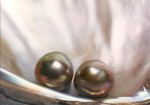Kasumigaura Pearl

The Kasumigaura Pearl is a freshwater cultured pearl from Lake Kasumigaura in Japan. Pioneer Mr. Kazuhisa Yanase began cultivating these pearls, in the size of more than 10 mm, with a round nucleus, which are similar to South Sea pearls. He executed implantation of the molluscs himself. After seven years of hard work, he succeeded in harvesting beautiful pearls. To date, there are only three main farmers working in this sector. He has set up his own nursery for rearing the necessary mussels, where they are allowed to grow for three years. Then, it takes further three to four years after implantation until the pearls can be harvested.
Freshwater pearl farming began in Kasumigaura lake in 1962. The history of pearl farming in this lake is closely linked to Mr. Kazuhisa Yanase. He was the man who examined conditions in the lake to check whether pearl farming would be possible. On behalf of Uda Pearl, who was specialized in freshwater pearls and had farmed pearls in Lake Biwa right from the start, Mr. Yanase conducted the first experiments with molluscs from Lake Biwa and from other lakes. He soon discovered that it would be possible to establish pearl molluscs in Lake Kasumigaura. Tests revealed that conditions were so ideal that the pearls could reach bigger sizes.
Mr. Kazuhisa Yanase is one of the three existing cultivator at the lake Kasumigaura. Mr. Yanase cultivates the Kasumigaura Pearls in ponds to protect the shell against diseases. At the age of 2 the oyster gets through an operation a nucleus and a piece. After operation the oyster will be put back in nets. Before the harvest starts each oyster will be cleaned. After three years at the age of 5 the harvest will start. Each Kasumigaura oyster produces just only one pearl. The oyster covers the nucleus and the piece with a pearl sack, to protect them from each other. If you scratch the pearl sack the typical luster appears immediately. The Kasumigaura Pearls appear in many different colours from white, apricot to deep purple.
The Kasumigaura Oyster is an hybrid between the Hyriopsis cumingi and the Hyriopsis schlegeli. The typical colour variation of the Kasumigaura Pearl can be seen inside the shell.





